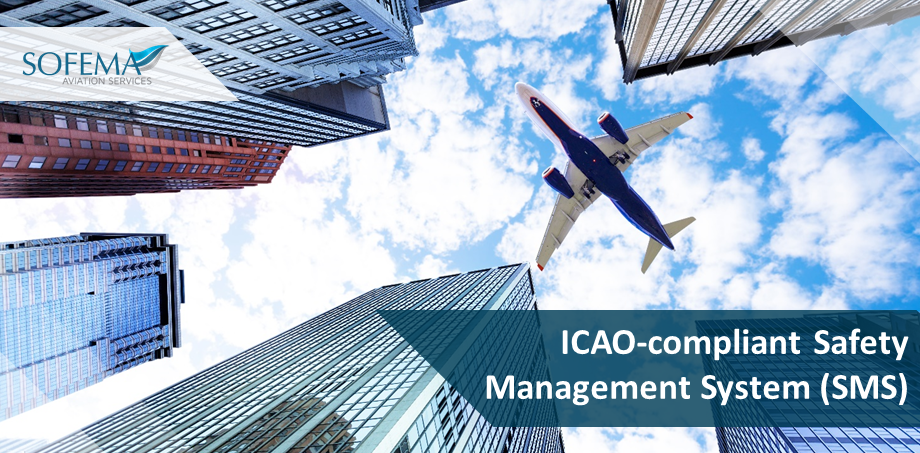Sofema Aviation Services (SAS) considers the key aspects of an ICAO-compliant Safety Management System (SMS)
Introduction
The International Civil Aviation Organization (ICAO) provides a framework for an Aviation Safety Management System (SMS) that is designed to manage safety risks in the aviation industry. A fully compliant SMS according to ICAO standards is structured around several key safety objectives.
A fully compliant SMS under ICAO guidelines aims to integrate safety into every aspect of aviation operations. By systematically addressing the above objectives, organizations can not only comply with international standards but also significantly enhance their operational safety, ultimately contributing to the overall safety of the global aviation environment.
Hazard Identification and Risk Management
- One of the primary safety objectives of an SMS is the proactive and systematic identification of hazards and the assessment and mitigation of risks associated with them.
- This involves continuous monitoring and analysis of operational data to detect potential hazards before they result in incidents or accidents. The goal is to implement measures that control or eliminate risks to an acceptable level.
Safety Assurance
- Safety assurance functions to ensure that the safety management activities are achieving the desired outcomes.
- This is accomplished through regular safety audits, monitoring of safety performance, and reviewing the effectiveness of safety risk controls.
- The idea is to have a feedback loop that continuously evaluates and improves safety processes, ensuring they work as intended and are effective over time.
Safety Promotion
- This objective focuses on fostering a positive safety culture within the organization.
- Safety promotion involves training, communication, and other activities that emphasize safety as a fundamental principle.
- This includes the development of competencies, the dissemination of safety information throughout the organization, and encouraging open communication on safety issues without fear of retribution.
Safety Policy and Objectives
- A clear and concise safety policy that outlines the safety principles, responsibilities, and accountabilities within the organization is crucial.
- This policy sets the foundation for safety operations and guides the development of specific safety objectives and plans.
o These objectives should be measurable and aligned with overall organizational goals, ensuring that safety is integrated into all aspects of operations.
Management Commitment and Responsibility
- Management plays a critical role in the effectiveness of an SMS. There must be a strong commitment from all management levels to support safety, demonstrating leadership and dedication to safety principles.
- This includes ensuring that the necessary resources are available for safety initiatives and that safety management is treated as a key component of the organizational strategy.
Continuous Improvement
- An SMS must not be static; continuous improvement is essential.
- This involves the regular review and enhancement of safety processes, informed by operational experience, external changes, and the outcomes of safety assurance activities.
- The system should evolve with advancements in technology, changes in operations, and as lessons are learned from safety events.
Emergency Response Planning
- Preparedness for emergency situations is another critical objective. Organizations should have comprehensive and tested emergency response plans that detail procedures for managing various types of emergencies, minimizing their impact on operations, and protecting both personnel and assets.
Conclusion
The systematic approach to hazard identification, risk management, safety assurance, and promotion forms the core of an effective SMS, ensuring not only adherence to ICAO standards but also fostering a robust safety culture throughout the organization.
- The clear definition of safety policies, along with measurable safety objectives, establishes a solid foundation for continuous improvement and management commitment.
- Moreover, the emphasis on emergency response preparedness exemplifies the comprehensive scope of an SMS, preparing organizations to handle unexpected situations effectively.
- By integrating these elements, an SMS becomes a dynamic and responsive system capable of adapting to new challenges and maintaining high safety standards, thereby contributing to the overall safety and reliability of global aviation operations.
Next Steps
Follow this link to our Library to find & download related documents for Free
For ICAO and EASA – Compliant Safety Management System Training available as Classroom, Webinar or Online Training please see Sofema Aviation Sevices or Sofema Online For more information, comments or questions please contact team@sassofia.com
Tags:
aviation safety, Civil Aviation Organisation (ICAO), Emergency Response Planning, global aviation, International Civil Aviation Organization (ICAO), Organisations Safety Objectives, Risk Management, Safety Assurance, Safety Audits, Safety Culture, Safety Management Activities, Safety Objectives, safety performance, Safety Policy, Safety Principles, safety risk controls, SAS blogs




